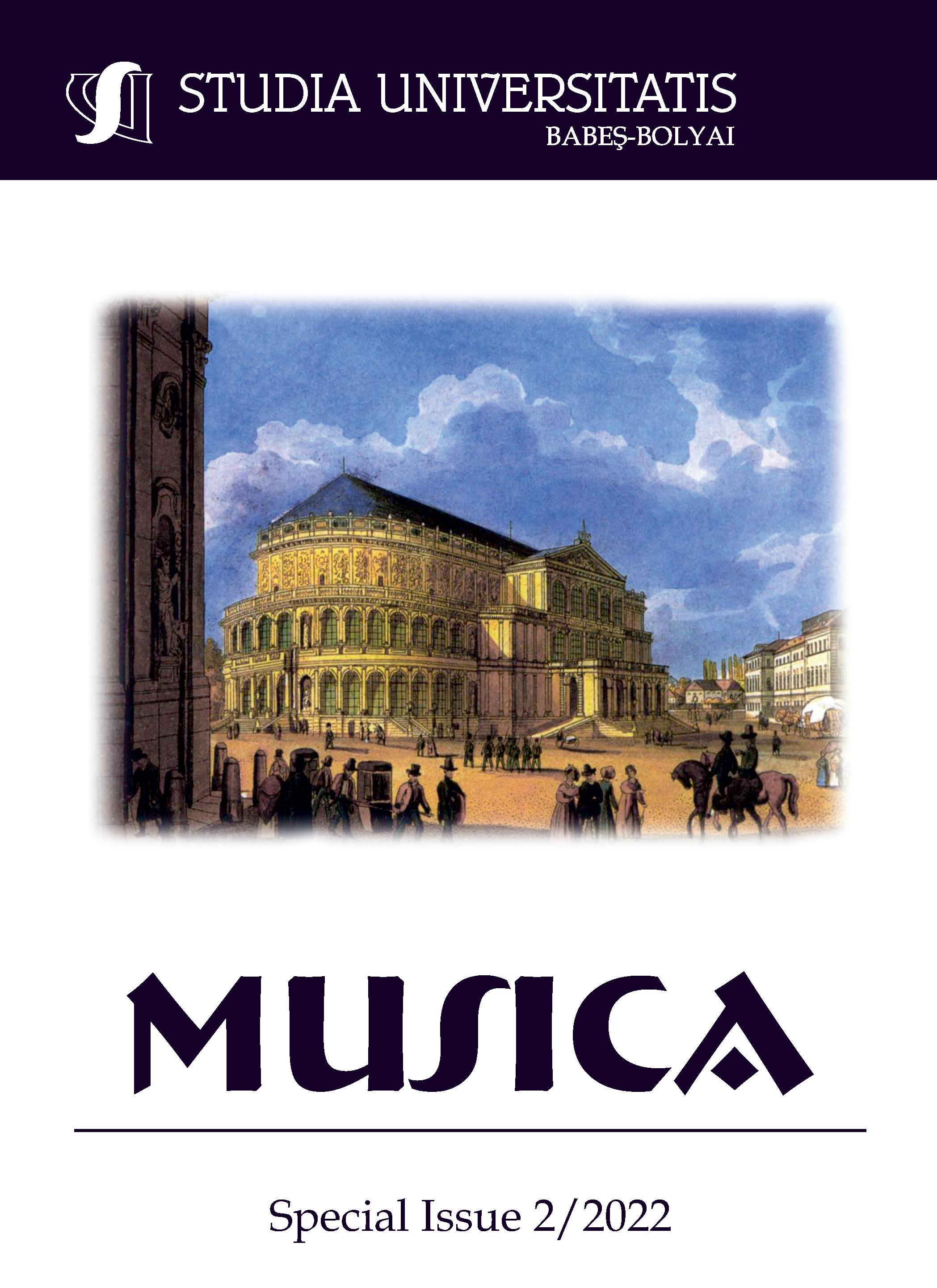REFERENCES INDIAN RHYTHMIC GESTURE AND TINTA IN FRENCH OPERAS OF THE SECOND HALF OF THE 19ᵀᴴ CENTURY AND EARLY 20ᵀᴴ CENTURY
DOI:
https://doi.org/10.24193/subbmusica.2022.spiss2.03Keywords:
Hindu rhythm, ethnomusicology, French opera, orientalism, Indian tinta, timbreAbstract
As part of a larger study which compresses three layers of analyses — dramatic, visual, and musical — the present article deals with the rhythmic component of the musical phenomenon in French operas within a half century timeframe, 1862–1923. Orientalism and exoticism were represented through melody, rhythm, timbre, and libretti in operas by F. David, G. Bizet, L. Delibes, J. Massenet, and A. Roussel. The melodic dimension, discussed in a previous study, offered perhaps more opportunities for the evocation of an allegedly oriental sound than rhythm and meter deliver within the operas, while the timbre of various instruments proposes the sensuality of the Orient — an accepted Western stereotype regarding the East. To identify certain rhythmic formulae of Indian inspiration and to understand the concept of tāla, several studies and works of Indian musicians and authors have been consulted, among these Sãrngadeva’s Sangītaratnākara, a thirteenth century treatise considered one of the most important Indian musicological texts. Whether invented or extracted directly from its original source, the article aims to identify composers’ rhythmic gestures. The blend of personal musical language with the Indian tinta reflected in rhythmic patterns create a romantic texture cognoscible to the discussed French exotic operas: David’s opéra-comique Lalla-Roukh, Bizet’s Les Pecheurs de perles, Delibes’ Lakmé, Massenet’s five-act grand-opéra Le Roi du Lahore, and Roussel’s opéra-ballet Padmâvatî.
References
***Encyclopedie de la Musique et Dictionnarie du Conservatoire — Première Partie, Tome I, Directeur: Albert Lavignac. Librairie Ch. Delagrave, Paris, 1914.
Boulanger, Nadia. “L’œuvre theatrale d’Albert Roussel,” La Revue Musicale, 10/6-7 (1929), 104-12, 38–52.
Clayton, Martin. Time in Indian Music: Rhythm, Metre, and Form in North Indian Rāg Performance. Oxford University Press, 2008.
Eddins, John Marion. The Symphonic Music of Albert Roussel — PhD. diss., The Florida State University, 1966.
Inden, Richard. Imagining India. Indiana University Press, 1990.
Kippen, James. R.: “Hindustani Tala” in Nettl, Bruno; Ruth M. Stone; James Porter; Timothy Rice. The Garland Encyclopedia of World Music: South Asia: The Indian subcontinent. Garland Publishing, New York, and London, 2000.
Kulshreshtha, Khushboo. History & Evolution of Indian Music. Shree Natraj Prakashan, New Delhi, 2010.
Locke, Ralph P. “Cutthroats and Casbah Dancers, Muezzins and Timeless Sands: Musical Images of the Middle East in 19th-Century Music”, Vol. 22, No. 1 (Summer, 1998), pp. 20–53, University of California Press.
Locke, Ralph P. 1991. “Constructing the Oriental ‘Other’: Saint Saëns’ “Samson et Dalila”. Cambridge Opera Journal, Vol. 3 No. 3, Nov. 1991, (p. 261–302).
Marsh, Kate. India in the French Imagination: Peripheral Voices 1754–1815. Pickering & Chatto, London, 2009.
Mohan, Jyoti. Claiming India: French Scholars and the Preoccupation with India in the Nineteenth Century. SAGE Publications, 2018.
Nelson, David Paul: “Karnatak Tala” in Nettl, Bruno; Ruth M. Stone; James Porter; Timothy Rice. The Garland Encyclopedia of World Music: South Asia: The Indian subcontinent. Garland Publishing, New York, and London, 2000.
Parakilas, James. The Soldier and the Exotic: Operatic Variations on a Theme of Racial Encounter, Part I. The Opera Quarterly, 1993, Vol. 10, Iss. 2 (p. 33–56).
Pincherle, Mark. Albert Roussel. Wilhelm Limpert-Verlag, London, 1957.
Popley, Herbert A. The Music of India. Calcutta: Association Press, London: Oxford, 1921.
Potter, Caroline and Langham-Smith, Richard. French Music Since Berlioz, Routledge, London, and New York, 2016.
Rîpã, Constantin. Teoria superioară a muzicii. Ritmul (Higher Theory of Music. The Rhythm), Vol. II, Editura MediaMusica, Cluj-Napoca, 2002.
Rowell, Lewis: Theoretical Treatises in Nettl, Bruno; Ruth M. Stone; James Porter; Timothy Rice. The Garland Encyclopedia of World Music: South Asia: The Indian subcontinent. Garland Publishing, New York, and London, 2000.
Said, Edward. Orientalism. Penguin Books, London, 2003.
Tiersot, Julien. Notes d’ethnographie musicale — Première Série. Librairie Fischbacher, Paris, 1905.
Scores:
Bizet, Georges. Les pêcheurs de perles. Antoine Choudens, Paris, 1863.
David, Félicien. Lalla-Roukh. E. Girod, Paris, 1862.
Delibes, Léo. Lakmé. Heugel, Paris, 1883.
Massenet, Jules. Le roi du Lahore. G. Hartmann, Paris, 1877.
Roussel, Albert. Padmâvatî. Durand &Cie., Paris, 1919.
Downloads
Published
How to Cite
Issue
Section
License
Copyright (c) 2022 Studia Universitatis Babeș-Bolyai Musica

This work is licensed under a Creative Commons Attribution-NonCommercial-NoDerivatives 4.0 International License.






